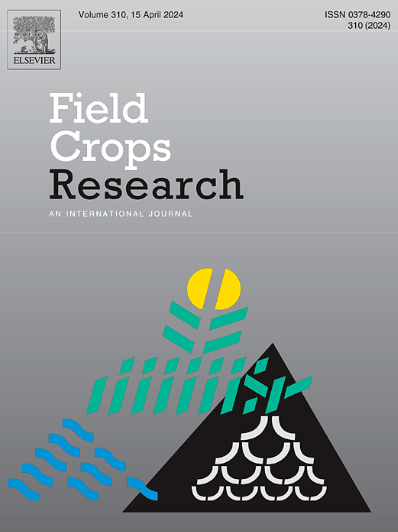Soil surface management for enhanced morpho-physiological traits, yield and water use efficiency of chickpea: A sustainable and climate resilient strategy
IF 5.6
1区 农林科学
Q1 AGRONOMY
引用次数: 0
Abstract
Context
Soil surface management significantly impacts agricultural production and food security by affecting soil environment and crop yields. However, research on how different soil surface management practices influence morpho-physiology, yield and WUE of chickpea (Cicer arietinum L.) under Vertisols (Typic Chromoustert) remains notably insufficient. Hence, there is need to develop conservation-based climate resilient recommendations for pulses beyond cereal-dominated systems.
Methods
A field experiment was conducted over three consecutive rabi seasons (2020–21–2022–23) comparing three soil surface management practices namely conventional farmers’ practice (CT), fresh broad bed and furrow planting system (FBB) and permanent broad bed and furrow planting system with crop residue mulching (PBB + CR). Key parameters assessed included morpho-physiological traits, yield, WUE, and economic budgeting.
Results
Our findings revealed that FBB and PBB + CR treatments enhanced the root nodulation by 38.6 % and 58.0 % (averaged over 2020–21–2022–23), respectively compared to CT. The PBB + CR treatment increased chlorophyll “a” and “b” content by 20.6 % and 19.5 %, respectively, and seed yield by 17.3 %. The highest yield increment (19.9 %) was recorded in the second year under PBB + CR. Water use efficiency improved by 29.1 % under PBB + CR and by 15.6 % under FBB. Moreover, PBB + CR resulted in a 22.9 % increase in three-year average net returns over CT. Photosynthetic pigments were significantly (p ≤ 0.001) and positively correlated with seed yield, highlighting its utility as a physiological indicator under semi-arid conditions.
Conclusions
Soil surface management practices, particularly PBB + CR could be a sustainable and climate resilient approach to conserve resources while boosting productivity and profitability. The PBB + CR system offers a viable adaptation-led climate change mitigation strategy and can be recommended for broader adoption in Vertisols (Typic Chromoustert) of rainfed and semi-arid agro-ecologies worldwide.
提高鹰嘴豆形态生理性状、产量和水分利用效率的土壤表面管理:可持续和气候适应性策略
土壤表面管理通过影响土壤环境和作物产量,对农业生产和粮食安全产生重大影响。然而,不同土壤表面管理措施对垂直土壤(Typic Chromoustert)下鹰嘴豆(Cicer arietinum L.)形态生理、产量和水分利用效率的影响研究仍显不足。因此,有必要为以谷物为主的系统以外的豆类制定基于保护的气候适应性建议。方法通过连续3个rabi季节(2020-21-2022-23)的田间试验,比较了常规农作(CT)、新鲜宽床沟播(FBB)和作物残茬覆盖永久宽床沟播(PBB + CR) 3种土壤表面管理方式。评估的关键参数包括形态生理性状、产量、水分利用效率和经济预算。结果与CT相比,FBB和PBB + CR处理对根结瘤的促进作用分别为38.6 %和58.0 %(平均超过2020-21-2022-23)。PBB + CR处理使叶绿素a和b含量分别提高20.6 %和19.5 %,种子产量提高17.3 %。在PBB + CR下,第二年的产量增幅最高(19.9 %)。水利用效率在PBB + CR下提高了29.1 %,在FBB下提高了15.6 %。此外,与CT相比,PBB + CR导致三年平均净收益增加22.9% %。光合色素与种子产量呈显著正相关(p ≤ 0.001),表明其在半干旱条件下作为生理指标的效用。结论土壤表面管理实践,特别是PBB + CR可以是一种可持续的、具有气候适应性的方法,在节约资源的同时提高生产力和盈利能力。PBB + CR系统提供了一种可行的以适应为主导的气候变化减缓战略,可以推荐在全球雨养和半干旱农业生态的Vertisols (typicchromoustert)中广泛采用。
本文章由计算机程序翻译,如有差异,请以英文原文为准。
求助全文
约1分钟内获得全文
求助全文
来源期刊

Field Crops Research
农林科学-农艺学
CiteScore
9.60
自引率
12.10%
发文量
307
审稿时长
46 days
期刊介绍:
Field Crops Research is an international journal publishing scientific articles on:
√ experimental and modelling research at field, farm and landscape levels
on temperate and tropical crops and cropping systems,
with a focus on crop ecology and physiology, agronomy, and plant genetics and breeding.
 求助内容:
求助内容: 应助结果提醒方式:
应助结果提醒方式:


